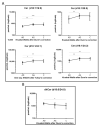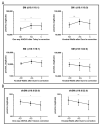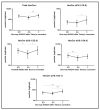Novel Insight into the Serum Sphingolipid Fingerprint Characterizing Longevity
- PMID: 35269570
- PMCID: PMC8910653
- DOI: 10.3390/ijms23052428
Novel Insight into the Serum Sphingolipid Fingerprint Characterizing Longevity
Abstract
Sphingolipids (SLs) are structural components of the lipid bilayer regulating cell functions. In biological fluids, their distribution is sex-specific and is at variance in aging and many disorders. The aim of this study is to identify SL species associated with the decelerated aging of centenarians. SLs, extracted from serum of adults (Ad, 35-37 years old), aged (Ag, 75-77 years old) and centenarian (C, 105-107 years old) women were analyzed by LC-MS/MS in combination with mRNA levels in peripheral blood mononuclear cells (PBMCs) of SL biosynthetic enzymes. Results indicated in Ag and C vs. Ad a comparable ceramides (Cers) increase, whereas dihydroceramide (dhCer) decreased in C vs. Ad. Hexosylceramides (HexCer) species, specifically HexCer 16:0, 22:0 and 24:1 acyl chains, increased in C vs. Ag representing a specific trait of C. Sphingosine (Sph), dihydrosphingosine (dhSph), sphingosine-1-phosphate (S1P) and dihydrosphingosine-1-phosphate (dhS1P), increased both in Ag and C vs. Ad, with higher levels in Ag, indicating a SL fine-tuning associated with a reduced physiological decline in C. mRNA levels of enzymes involved in ceramide de novo biosynthesis increased in Ag whereas enzymes involved in sphingomyelin (SM) degradation increased in C. Collectively, results suggest that Ag produce Cers by de novo synthesis whereas C activate a protective mechanism degrading SMs to Cers converting it into glycosphingolipids.
Keywords: ROS; aging; centenarians; longevity; mass spectrometry; nitric oxide; sphingolipids.
Conflict of interest statement
The authors declare no conflict of interest. The funders had no role in the design of the study; in the collection, analyses, or interpretation of data; in the writing of the manuscript, or in the decision to publish the results.
Figures








Similar articles
-
Blood sphingolipidomics in healthy humans: impact of sample collection methodology.J Lipid Res. 2010 Oct;51(10):3074-87. doi: 10.1194/jlr.D008532. Epub 2010 Jul 21. J Lipid Res. 2010. PMID: 20660127 Free PMC article.
-
Development of an advanced liquid chromatography-tandem mass spectrometry measurement system for simultaneous sphingolipid analysis.Sci Rep. 2024 Mar 8;14(1):5699. doi: 10.1038/s41598-024-56321-w. Sci Rep. 2024. PMID: 38459112 Free PMC article.
-
Disruption of sphingolipid metabolism augments ceramide-induced autophagy in preeclampsia.Autophagy. 2015 Apr 3;11(4):653-69. doi: 10.1080/15548627.2015.1034414. Autophagy. 2015. PMID: 25853898 Free PMC article.
-
The role of dihydrosphingolipids in disease.Cell Mol Life Sci. 2019 Mar;76(6):1107-1134. doi: 10.1007/s00018-018-2984-8. Epub 2018 Dec 6. Cell Mol Life Sci. 2019. PMID: 30523364 Free PMC article. Review.
-
Alteration of Sphingolipids in Biofluids: Implications for Neurodegenerative Diseases.Int J Mol Sci. 2019 Jul 21;20(14):3564. doi: 10.3390/ijms20143564. Int J Mol Sci. 2019. PMID: 31330872 Free PMC article. Review.
Cited by
-
Serum metabolic and microbial profiling yields insights into promoting effect of tryptophan-related metabolites for health longevity in centenarians.Imeta. 2025 Apr 20;4(3):e70025. doi: 10.1002/imt2.70025. eCollection 2025 Jun. Imeta. 2025. PMID: 40469513 Free PMC article.
-
The lipidomes of C. elegans with mutations in asm-3/acid sphingomyelinase and hyl-2/ceramide synthase show distinct lipid profiles during aging.Aging (Albany NY). 2023 Feb 13;15(3):650-674. doi: 10.18632/aging.204515. Epub 2023 Feb 13. Aging (Albany NY). 2023. PMID: 36787434 Free PMC article.
-
Phenotypic upregulation of hexocylceramides and ether-linked phosphocholines as markers of human extreme longevity.Aging Cell. 2025 Apr;24(4):e14429. doi: 10.1111/acel.14429. Epub 2024 Dec 5. Aging Cell. 2025. PMID: 39639682 Free PMC article.
-
The Biomarkers in Extreme Longevity: Insights Gained from Metabolomics and Proteomics.Int J Med Sci. 2024 Oct 21;21(14):2725-2744. doi: 10.7150/ijms.98778. eCollection 2024. Int J Med Sci. 2024. PMID: 39512690 Free PMC article. Review.
-
Sex Differences in Cardiovascular Diseases: A Matter of Estrogens, Ceramides, and Sphingosine 1-Phosphate.Int J Mol Sci. 2022 Apr 4;23(7):4009. doi: 10.3390/ijms23074009. Int J Mol Sci. 2022. PMID: 35409368 Free PMC article. Review.

